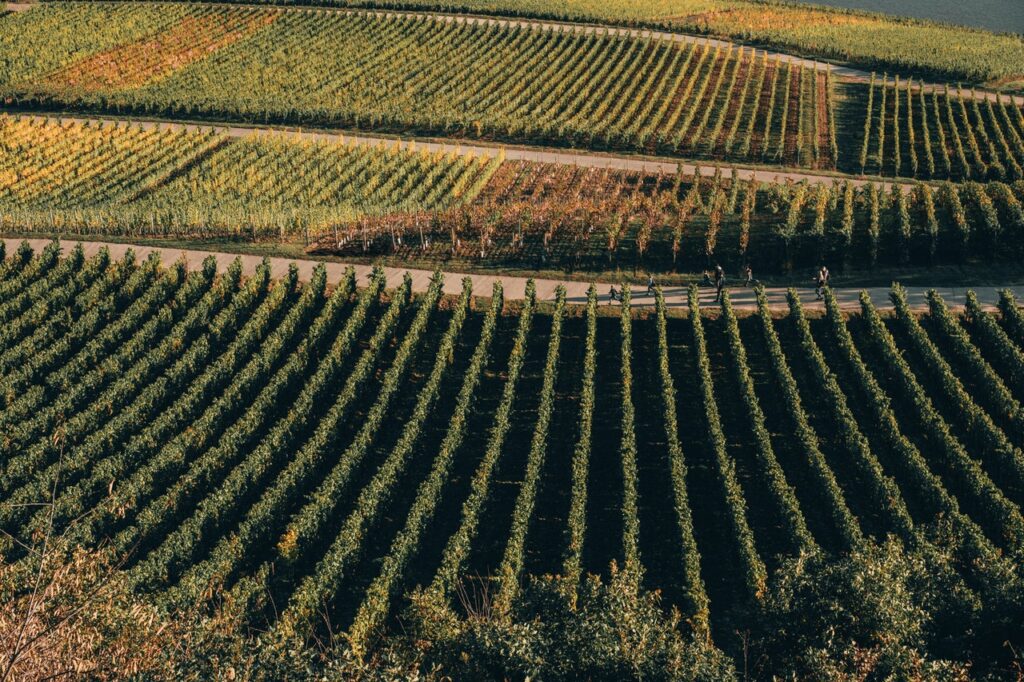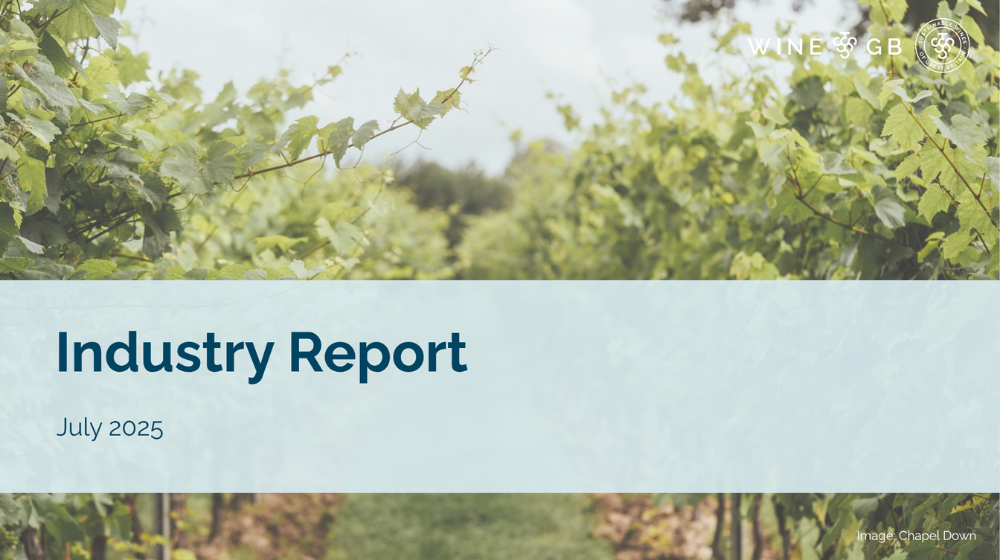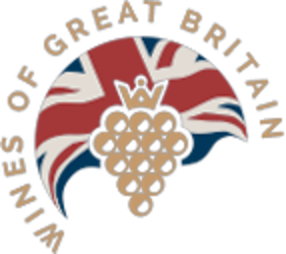
WineGB Industry Report: English and Welsh wine shows resilience and growth

WineGB has released its latest Industry Report with updated figures on hectarage, production, sales and employment. Despite the economic and political conditions, the sector has grown sales and production.
The Industry Report 2025 reveals that vineyard numbers have increased by 74 to hit 1,104 with 25 newly registered wineries bringing the total to 238. The area under vine has also grown from 4,209 hectares to 4,841ha, representing a growth rate of 510% since 2005.
Production
Kent continues to be the most planted county, accounting for almost double the area of the next vine-dense county of West Sussex. Recent plantings have lifted Essex to third, leapfrogging both East Sussex and Hampshire. Dorset has also climbed to seventh, behind Surrey, with Gloucestershire, Devon and Suffolk making up the top 10.
In terms of grape varieties, the top six remain unchanged. Pinot Gris has risen to become the seventh most planted variety followed by Reichensteiner, Rondo and Pinot Blanc. Chardonnay has increased its dominance, now constituting 33% of plantings (up from 31%), with Pinot Noir also increasing its share to 30%.
There are now 99 different grape varieties planted in the UK, including 37ha of Sauvignon Blanc, 8ha of Gamay, 4.5ha of Albariño, 3ha of Merlot, and 2ha of Riesling. The last two years have seen the first plantings of Grenache, Nebbiolo, Marsanne, Savagnin, Tempranillo, and Viognier, while varieties such as Cabernet Sauvignon, Cabernet Franc, Chenin Blanc, Gewürztraminer, Pinotage, and Syrah can also be found growing in the UK, albeit in small volumes.
With challenging conditions experienced across much of northern Europe, 2024 saw a reduction in total production. According to the Food Standards Agency Wine Team, there were over 10.6 million bottles produced last year, higher than originally estimated due to more up-to-date active hectarage figures being used.
While the average yield was the lowest since 2016 (21.3hl/ha), the increase in overall vineyard area means that 2024 achieved the fourth highest production volume overall. The split between sparkling and still wine production (69% vs. 31%) was more in line with the long-term average. There was also a higher proportion of still rosé wine made in 2024, rising to 25% compared with 20% in 2023.
Sales
Sales by volume increased by 3% overall in 2024. Sales of sparkling wine maintained last year’s volumes, a laudable achievement given the reduction in sales within other premium sparkling wine categories last year.1 This also follows a swathe of punishing regulatory changes including increases in alcohol duty and National Insurance contributions, changes to Inheritance Tax, and the roll out of Extended Producer Responsibility fees. Meanwhile, sales of still wine increased by 10% in part due to higher production volumes achieved in 2023 resulting in more wine available for sale.
In terms of sales channels, off-trade national accounts and the on-trade made up the largest share at just at 26% apiece. Cellar door sales saw a small decline for the second consecutive year, but overall direct-to-consumer sales (including producer’s online sales) accounted for 30% of the total. There was an increase in wine sold through independent retail (9% in 2024 vs. 6% in 2023) and also through exports (9% in 2024 vs. 8% in 2023).
WineGB analysis of sales channel split by producer size shows that larger producers continue to be less reliant on direct-to-consumer sales and are increasing the percentage of sales sold through the trade and export. Conversely, medium and small producers rely more heavily on direct sales together with local on-trade and independent retail accounts.
Employment
Finally, in 2024, full-time equivalent (FTE) positions within the industry now stand at 3,300. Roles in hospitality saw the biggest rise due to continued investment in cellar door operations. According to the WineGB Industry Survey, 90% of respondents expect to increase their staffing by 2028 resulting in an overall 21% increase in FTE roles.
Commenting on the latest data release, WineGB CEO Nicola Bates says: “Our industry shows resilience and remains in a growth phase with planting and employment continuing to show an upward trend. A 3% growth in sales is a notable achievement given the current economic climate, recent regulatory changes, and the fact that our producers continue to face considerable economic barriers not seen in mature markets. A slew of national and international accolades for GB wines this year – including the first ever 99 points at the WineGB Awards – continues to demonstrate the quality of our wines in a global setting. It is time that the Government puts the necessary support into the most on-trend wine region so we can take advantage and really build the category – or we risk missing our chance.”
Three Government initiatives needed to help grow the UK domestic wine sector:
- Introduce Wine Tourism Relief – support multi-skilled jobs in the countryside.
- Improve grants for kit, education, R&D and marketing – in the last decade, many grants have disappeared putting us at a disadvantage against European Old World wine regions.
- Protect our terms and aid consumer choices – only classify British wine as coming from British grapes and don’t add barriers to our wines getting onto shelf.
1 According to Comité Champagne, total Champagne shipments in 2024 were down 9.2% from 2023 to reach 271.4m bottles (https://www.champagne.fr/en/find-out-more/mediaroom/champagne-press/271-million-bottles-shipped-2024), including a 12.7% decrease in shipments to the UK (https://www.thedrinksbusiness.com/2025/03/champagne-shipments-to-uk-drop-by-13-in-2024/). D.O. Cava also reported a 13.39% reduction in sales compared with 2023.
Ends.
For more information, please contact Phoebe French (phoebe@temp.winegb.co.uk / 07591588328).
WineGB
Wines of Great Britain (WineGB) is the national association for the English and Welsh wine industry. It represents, leads, and supports the sustainable growth of the Great British wine sector. With over 500 members, it works to cultivate success across the industry. Its work supports its three key areas of activity: to ensure strong production and a skilled workforce, to increase sales and safeguard quality, and to enhance the reputation of English and Welsh wine.
The WineGB Industry Report 2025 can be downloaded here.
Content for this report has been principally sourced from data provided by the Food Standards Agency Wine Team as well as the results from the WineGB Industry Survey 2025. The Industry Survey is sent to both members and non-members of WineGB and captured the equivalent of 90% of production. Sources are clearly labelled at the bottom of each page. More information on methodology is provided on the last page of the report.
Explore WineGB


